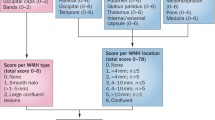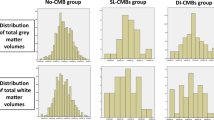Summary
The pathophysiology and clinical significance of high signal lesions, visualized on magnetic resonance imaging (MRI) in patients with Alzheimer's disease (AD), remain controversial. Since they are known to correlate with vascular disease and vascular risk factors, we reviewed the clinical correlates of periventricular high signal (PVH) and subcortical white matter lesions (WML) in a sample of 106 patients with probable AD, excluding persons with treated vascular risk factors or symptomatic cerebrovascular and cardiovascular disease. Grade 2 PVH were seen in 26 (25%) and scattered WML were identified in 29 (18%). PHV were associated with advancing age and gait disturbance. WML were associated with gait disturbance and incontinence. Neither radiologic finding was related to dementia severity. The findings suggest that these lesions are common in patients with AD even when those with evidence of cerebrovascular disease are excluded; their presence, therefore, should not preclude a diagnosis of AD. Additionally, the data suggest that HSL on MRI may be one of many risk factors associated with functional disability in persons with probable AD.
Similar content being viewed by others
References
Austrom MG, Thompson RF, Hendrie HC, et al (1990) Foci of increased T2 signal intensity in MR images of healthy elderly subjects. A follow-up study. J Am Geriatr Soc 38:1133–1138
Awad IA, Johnson PC, Spetzler RF, et al (1986) Incidental subcortical lesions identified on magnetic resonance imaging in the elderly. II. Postmortem pathological correlations. Stroke 17:1090–1097
Awad IA, Spetzler RF, Hodak JA, et al (1986) Incidental subcortical lesions identified on magnetic resonance imaging in the elderly. I. Correlation with age and cerebrovascular risk factors. Stroke 17:1084–1089
Bennett DA, Wilson RS, Gilley DW, Fox JH (1990) Clinical diagnosis of Binswanger's disease. J Neurol Neurosurg Psychiatry 53:961–965
Bennett DA, Charletta D, Gilley DW, Cochran E, Hayes K (1991) Clinical correlates of high signal lesions on MRI in pathologically proven Alzheimer's disease. Neurology 41[Suppl 1]:407
Bondareff W, Raval J, Woo B, et al (1990) Magnetic resonance imaging and the severity of dementia in older adults. Arch Gen Psychiatry 47:47–51
Braffman BH, Zimmerman RA, Trojanowski JQ, et al (1988) Brain MR: pathologic correlation with gross and histopathology. 2. Hyperintense white-matter foci in the elderly. Am J Neuroradiology 9:629–636
Brun A, Englund E (1986) A white matter disorder in dementia of the Alzheimer type: a pathoanatomical study. Ann Neurol 19:253–262
Cox DR (1970) Analysis of binary data. Methuen, London
De la Monte SM (1989) Quantitation of cerebral atrophy in preclinical and end-stage Alzheimer's disease. Ann Neurol 25:450–459
Englund E, Brun A, Persson B (1987) Correlations between histopathologic white matter changes and proton MR relaxation times in dementia. Alzheimer Dis Assoc Disord 1:156–170
Fazekas F, Chawluk JB, Alavi A, et al (1987) MR signal abnormalities at 1.5 T in Alzheimer's dementia and normal aging. Am J Neuroradiology 8:421–426
Fazekas F, Niederkorn K, Schmidt R, et al (1988) White matter signal abnormalities in normal individuals: correlation with carotid ultrasonography, cerebral blood flow measurements, and cerebrovascular risk factors. Stroke 19:1285–1288
Folstein MF, Folstein SE, McHugh PR (1975) “Mini-Mental State”: a practical method for grading the cognitive state of patients for the clinician. J Psychiatr Res 12:189–198
Fox JH, Topel JL, Huckman MS (1975) Use of computerized tomography in senile dementia. J Neurol Neurosurg Psychiatry 38:948
Fox JH, Penn R, Clasen R, et al (1985) Pathological diagnosis in clinically typical Alzheimer's disease. N Engl J Med 313:1419–1420
Galasko D, Klauber MR, Hofstetter R, et al (1990) The Mini-Mental State Examination in the early diagnosis of Alzheimer's disease. Arch Neurol 47:49–52
Hachinski VC, Potter P, Merskey H (1987) Leukoaraiosis. Arch Neurol 44:21–23
Hendrie HC, Farlow MR, Austrom MG, et al (1989) Foci of increased T2 signal intensity on brain MT scans of healthy elderly subjects. Am J Neuroradiol 10:703–707
Janota I, Mirsen TR, Hachinski VC, et al (1989) Neuropathologic correlates of leuko-araiosis. Arch Neurol 46:1124–1128
Johnson KA, Davis KR, Buonanno FS, et al (1987) Comparison of magnetic resonance and roentgen ray computed tomography in dementia. Arch Neurol 44:1075–1080
Jungreis CA, Kanal E, Flirsch WL, et al (1988) Normal perivascular spaces mimicking lacunar infarction: MR imaging. Radiology 169:101–104
Kaszniak AW, Garron DC, Fox JH, et al (1979) Cerebral atrophy, EEG slowing, age, education, and cognitive functioning in suspected dementia. Neurology 29:1273–1279
Kemper T (1984) Neuroanatomical and neuropathological changes in normal aging and in dementia. In: Albert ML (ed) Clinical neurology of aging. Oxford University Press, Oxford, pp 9–52
Khachaturian ZS (1985) Diagnosis of Alzheimer's disease. Arch Neurol 42:1097–1104
Kinkel WR, Jacobs L, Polachini I, et al (1989) Subcortical arteriosclerotic encephalopathy (Binswanger's disease): computed tomographic, nuclear magnetic resonance and clinical correlations. Arch Neurol 42:951–959
Koller WC, Wilson RS, Glatt SL, Huckman MS, Fox JH (1983) Senile gait: correlation with computed tomographic scans. Ann Neurol 13:343–344
Koller WC, Glatt SL, Fox JH (1985) Senile gait: a distinct neurologic entity. In: Radebaugh TS, Hadley E, Suzman R (eds) Falls in the elderly: biologic and behavioral aspects. Saunders, Philadelphia, p 661
Kozachuk WE, DeCarli C, Horwitz B, et al (1990) White matter hyperintensities in dementia of the Alzheimer type and in healthy subjects without cerebrovascular risk factors: a MRI study. Arch Neurol 47:1306–1310
Lawton MP, Brody E (1969) Assessment of older people: self maintaining and instrumental activities of daily living. Gerontologist 9:179–186
Leys D, Soetaert G, Petit H, et al (1990) Periventricular and white matter magnetic resonance imaging hyperintensities do not differ between Alzheimer's disease and normal aging. Arch Neurol 47:524–527
Leys D, Pruvo JP, Parent M, et al (1991) Could Wallerian degeneration contribute to “leuko-araiosis” in subjects free from any vascular disorder? J Neurol Neurosurg Psychiatry 54:46–50
Lieberman A, Dziatolowski M, Gopinathan G, et al (1980) Evaluation of Parkinson's disease. In: Goldstein M, Calne DB, Lieberman A, Thorner MO (eds) Ergot compounds and brain function: neuroendocrine and neuropsychiatric aspects. Raven Press, New York, p 277
Masdau JC, Wolfson L, Lantos G, et al (1989) Brain white-matter changes in the elderly prone to falling. Arch Neurol 46:1292–1296
McKhann G, Drachman D, Folstein M, et al (1984) Clinical diagnosis of Alzheimer's disease: report of the NINCDS-ADRDA Work Group under the auspices of Department of Health and Human Services Task Force on Alzheimer's Disease. Neurology 34:939–944
Morris JC, Heyman A, Mohs RC, et al (1989) The consortium to establish a registry for Alzheimer's disease (CERAD). 1. Clinical and neuropsychological assessment of Alzheimer's disease. Neurology 39:1159–1165
Rao SM, Mittenberg W, Bernardin L, et al (1989) Neuropsychological test findings in subjects with leukoaraiosis. Arch Neurol 46:40–44
Resnick NM, Yalla SV, Laurino E (1989) The pathophysiology of urinary incontinence among institutionalized elderly persons. N Engl J Med 320:1–7
Roman GC (1987) Senile dementia of the Binswanger type: a vascular form of dementia in the elderly. JAMA 258:1782–1788
Salmon DP, Thal LJ, Butters N, Heindel WC (1990) Longitudinal evaluation of dementia of the Alzheimer type: a comparison of 34 standardized mental status examinations. Neurology 40:1225–1230
Steingart A, Hachinski VC, Lau C, et al (1987) Cognitive and neurologic findings in subjects with diffuse white matter lucencies on computed tomographic scan (leukoaraiosis). Arch Neurol 44:32–35
Sudarsky L, Ronthal M (1983) Gait disorders among elderly patients. A survey study of 50 patients. Arch Neurol 40:740–743
Tinetti ME, Speechley M, Ginter SF (1988) Risk factors for falls among elderly persons living in the community. N Engl J Med 319:1701–1707
Williams ME, Pannill FC (1982) Urinary incontinence in the elderly. Physiology, pathophysiology, diagnosis and treatment. Ann Intern Med 97:895–907
Author information
Authors and Affiliations
Rights and permissions
About this article
Cite this article
Bennett, D.A., Gilley, D.W., Wilson, R.S. et al. Clinical correlates of high signal lesions on magnetic resonance imaging in Alzheimer's disease. J Neurol 239, 186–190 (1992). https://doi.org/10.1007/BF00839137
Received:
Revised:
Accepted:
Issue Date:
DOI: https://doi.org/10.1007/BF00839137




